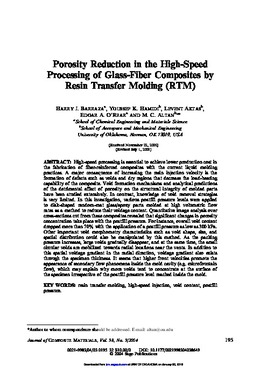| dc.contributor.author | Harry J. Barraza | |
| dc.contributor.author | Youssef K. Hamidib | |
| dc.contributor.author | Levent Aktasb | |
| dc.contributor.author | | |
| dc.contributor.author | Edgar A. O’Rear | |
| dc.contributor.author | M. C. Altan | |
| dc.date.accessioned | 2016-01-14T19:52:41Z | |
| dc.date.accessioned | 2016-03-30T15:33:30Z | |
| dc.date.available | 2016-01-14T19:52:41Z | |
| dc.date.available | 2016-03-30T15:33:30Z | |
| dc.date.issued | 2004-02-01 | |
| dc.identifier.citation | Barraza, H. J., Hamidib, Y. K., Aktasb, Levent, O’Rear, E. A., & Altan, M. C. (2004). Porosity Reduction in the High-Speed Processing of Glass-Fiber Composites by Resin Transfer Molding (RTM). Journal of Composite Materials, 38(3), 195-226. doi: 10.1177/0021998304038649 | en_US |
| dc.identifier.uri | https://hdl.handle.net/11244/24854 | |
| dc.description.abstract | High-speed processing is essential to achieve lower production cost in the fabrication of fiber-reinforced composites with the current liquid molding practices. A major consequence of increasing the resin injection velocity is the formation of defects such as voids and dry regions that decrease the load-bearing capability of the composite. Void formation mechanisms and analytical predictions of the detrimental effect of porosity on the structural integrity of molded parts have been studied extensively. In contrast, knowledge of void removal strategies is very limited. In this investigation, various postfill pressure levels were applied to disk-shaped random-mat glass/epoxy parts molded at high volumetric flow rates as a method to reduce their voidage content. Quantitative image analysis over cross-sections cut from these composites revealed that significant changes in porosity concentration take place with the postfill pressure. For instance, overall void content dropped more than 70% with the application of a postfill pressure as low as 300 kPa. Other important void morphometry characteristics such as void shape, size, and spatial distribution could also be manipulated by this method. As the packing pressure increases, large voids gradually disappear, and at the same time, the small circular voids are mobilized towards radial locations near the vents. In addition to this spatial voidage gradient in the radial direction, voidage gradient also exists through the specimen thickness. It seems that higher front velocities promote the appearance of secondary flow phenomena inside the mold cavity (e.g. microfountain flow), which may explain why more voids tend to concentrate at the surface of the specimen irrespective of the postfill pressure level reached inside the mold. | en_US |
| dc.language.iso | en_US | en_US |
| dc.publisher | Journal of Composite Materials | |
| dc.subject | resin transfer molding | en_US |
| dc.subject | high-speed injection | en_US |
| dc.subject | void content | en_US |
| dc.subject | postfill pressure | en_US |
| dc.title | Porosity Reduction in the High-Speed Processing of Glass-Fiber Composites by Resin Transfer Molding (RTM) | en_US |
| dc.type | Research Article | en_US |
| dc.description.peerreview | Yes | en_US |
| dc.description.peerreviewnotes | https://us.sagepub.com/en-us/nam/manuscript-submission-guidelines | en_US |
| dc.identifier.doi | 10.1177/0021998304038649 | en_US |
| dc.rights.requestable | false | en_US |
